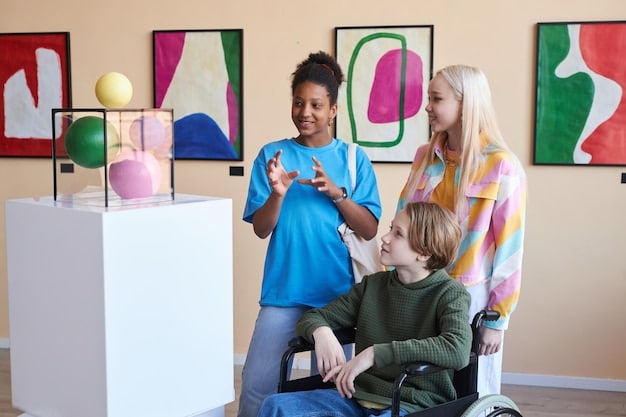IDEA Updates: How They Shape Your Child’s Education

The Individuals with Disabilities Education Act (IDEA) undergoes periodic updates to enhance educational support for children with disabilities, directly influencing their access to tailored services, individualized education programs (IEPs), and ensuring equitable opportunities for academic and personal growth within the U.S. education system.
For parents navigating the educational landscape for a child with disabilities, understanding the Individuals with Disabilities Education Act (IDEA) is paramount. This foundational federal law guarantees that children with disabilities receive the services they need to thrive in school. As the educational environment evolves, so too does IDEA, with updates designed to refine its implementation and improve outcomes for students.
Understanding the Foundation: What is IDEA?
The Individuals with Disabilities Education Act, commonly known as IDEA, is a critical piece of federal legislation in the United States. It ensures that public schools provide a free appropriate public education (FAPE) to eligible children with disabilities. This means that every child, regardless of the severity of their disability, has the right to receive special education and related services that meet their unique needs, at no cost to their parents.
IDEA is not merely a set of guidelines; it is a legally binding framework that provides a comprehensive pathway for identifying, evaluating, and educating children with disabilities from birth through high school graduation or age 21, whichever comes first. Its core principles are designed to protect the rights of children with disabilities and their parents, ensuring transparency and accountability in the educational process.
Historical Context and Evolution
IDEA originated from the Education for All Handicapped Children Act of 1975, a landmark bill that transformed the landscape of special education. Before this, many children with disabilities were excluded from public schools or received inadequate support. The 1975 act mandated that all states provide free and appropriate public education to children with disabilities, marking a significant societal shift. Over the decades, the law has been reauthorized and amended multiple times to reflect new research, societal changes, and evolving best practices in special education.
Each reauthorization has brought about important refinements. For instance, the 1997 amendments emphasized access to the general education curriculum and expanded the role of parents in decision-making. The most recent major reauthorization, in 2004, further strengthened accountability, improved instructional strategies, and aligned IDEA with other federal education initiatives like No Child Left Behind. These continuous updates ensure the law remains relevant and effective in addressing the diverse needs of students with disabilities.
The spirit of IDEA is rooted in inclusion. It aims to integrate children with disabilities into the least restrictive environment (LRE) possible, meaning they should be educated alongside their non-disabled peers to the maximum extent appropriate. This principle promotes a more equitable and integrated learning experience, fostering social, emotional, and academic development for all students.
- Free Appropriate Public Education (FAPE): Ensures all eligible children with disabilities receive special education and related services tailored to their needs.
- Least Restrictive Environment (LRE): Mandates that students with disabilities are educated with non-disabled peers to the greatest extent possible.
- Individualized Education Program (IEP): A legally binding document that outlines a child’s educational goals, services, and accommodations.
- Parent Participation: Emphasizes the crucial role of parents in all stages of their child’s special education process.
Understanding these foundational elements is the first step in navigating the complexities of special education. IDEA’s ongoing evolution signifies a commitment to improving educational outcomes and ensuring that every child has the opportunity to reach their full potential.
Ultimately, IDEA serves as a cornerstone of educational equality, continuously adapting to ensure that children with disabilities are not merely accommodated but are actively supported to achieve academic success and prepare for future independence.
Recent Legislative and Regulatory Adjustments to IDEA
While IDEA itself has not had a full-scale reauthorization since 2004, the act is continually influenced by various legislative and regulatory adjustments at both federal and state levels. These changes, though sometimes subtle, can have significant impacts on how the law is interpreted and applied in schools. Staying informed about these nuances is crucial for parents and educators alike to ensure compliance and effective implementation.
One of the primary drivers of ongoing adjustments comes from federal guidelines and policy letters issued by the U.S. Department of Education. These documents often clarify existing provisions, offer interpretations of the law, and provide guidance on emerging issues in special education. For instance, clarifications on topics like the use of restraint and seclusion, or the provision of services through virtual learning, have shaped practices in schools nationwide. These aren’t necessarily changes to the text of the law, but rather authoritative interpretations that schools must follow. These ongoing directives help to ensure consistency in how IDEA is implemented across states and provide necessary adaptations to new challenges or educational methodologies.
Impact of Other Federal Laws and Initiatives
IDEA does not operate in a vacuum; it often intersects with other federal laws and initiatives that can indirectly lead to regulatory adjustments. For example, the Every Student Succeeds Act (ESSA), which replaced No Child Left Behind, places a renewed emphasis on accountability for all students, including those with disabilities. While ESSA is a general education law, its requirements for state accountability systems, assessments, and school improvement plans often necessitate adjustments in how special education services are delivered and measured under IDEA. This ensures that students with disabilities are included in broader school accountability measures, promoting equitable outcomes.
Furthermore, federal budgets and appropriations can also influence the implementation of IDEA. Funding levels for special education programs, technical assistance centers, and research initiatives can directly affect the resources available to states and local school districts. While not a direct change to the law, these fiscal decisions can shape the capacity of schools to provide comprehensive services and implement best practices. Advocacy efforts often focus on ensuring adequate funding to support the spirit and letter of IDEA.
State-level legislation also plays a significant role. Many states pass their own laws and regulations that build upon or clarify IDEA’s provisions, often to address specific local needs or to reflect state policy priorities. These state laws must, at a minimum, meet the federal IDEA requirements, but they can also offer additional protections or services. For example, some states have implemented specific regulations regarding dyslexia screening or expanded transition services beyond what is explicitly detailed in federal IDEA.
- Clarifications from the U.S. Department of Education: Directives that interpret existing IDEA provisions and guide practical application.
- Intersections with ESSA: Requirements under ESSA for accountability and assessment that influence special education inclusion and progress monitoring.
- Federal Funding Decisions: Appropriations that impact resources available for special education services and programs.
- State-Specific Regulations: Laws and policies enacted by individual states that supplement or clarify federal IDEA guidelines.
These various layers of legislative and regulatory adjustments indicate that IDEA is a living framework, continuously being refined and interpreted to meet the contemporary needs of students with disabilities. It’s a dynamic process that requires ongoing vigilance from stakeholders to ensure its foundational principles remain intact and effective.
Keeping abreast of these regular updates, whether through official government publications or reputable advocacy organizations, empowers parents to be effective advocates for their children and helps educators stay compliant and effective in their roles.
Strengthening Parental Rights and Involvement
A cornerstone of IDEA has always been the emphasis on parental involvement, and recent interpretations and clarifications have further solidified these rights. Recognizing parents as crucial partners in their child’s education, IDEA ensures they have a prominent voice in all decisions related to identification, evaluation, placement, and the development of the Individualized Education Program (IEP). This partnership is essential for creating an effective and truly individualized educational experience.
One key area that has seen increased focus is the provision of informed consent. Parents must be fully informed about their child’s educational rights and options, and they must provide consent before evaluations are conducted or services are initiated. This isn’t a mere formality; it ensures that parents understand the implications of proposed actions and have the opportunity to ask questions or seek clarification. Schools are increasingly held to a higher standard in ensuring that this informed consent is truly meaningful, with accessible language and clear explanations.
Enhanced Communication and Access to Information
Another significant aspect of strengthening parental rights revolves around enhanced communication and timely access to information. Parents have the right to receive copies of all educational records related to their child, including evaluation reports, IEPs, progress reports, and disciplinary records. Furthermore, they are entitled to participate in all IEP team meetings, where critical decisions about their child’s education are made. Recent emphasis has been placed on ensuring these meetings are scheduled at mutually agreeable times and that parents receive advance notice.
The goal is to foster a transparent and collaborative environment where parents feel empowered to contribute their unique insights into their child’s strengths, needs, and aspirations. Schools are often encouraged to go beyond the minimum legal requirements, proactively engaging parents through regular updates, workshops, and accessible communication channels, especially for families with language barriers or other challenges.
Furthermore, parents have dispute resolution mechanisms available to them if disagreements arise with the school district. These include mediation, due process hearings, and state complaint procedures. While these have always been part of IDEA, guidance often reiterates the importance of these avenues as safeguards for parental rights. The emphasis is on resolving conflicts efficiently and amicably, always with the child’s best interests at heart.
- Informed Consent: Parents must give explicit consent for evaluations and service provision after being fully informed.
- Access to Records: Fundamental right to review and obtain copies of all educational records pertaining to their child.
- IEP Team Participation: Guaranteed right to attend and contribute to all meetings where IEPs are developed and reviewed.
- Dispute Resolution Pathways: Access to mediation, due process hearings, and state complaints to address disagreements with the school.

These strengthened parental rights are not just about compliance; they are about recognizing that parents are critical allies in ensuring a child with disabilities receives the most appropriate and effective education. Their unique perspective on their child’s development, learning style, and daily challenges is invaluable to the IEP process.
By empowering parents, IDEA helps create a more equitable and effective educational system that truly supports the holistic development of every child with disabilities.
Emphasis on Early Intervention and Transition Services
IDEA has long recognized the critical importance of early intervention for infants and toddlers with disabilities and the need for robust transition services for older students. Recent updates and guidance have reinforced these areas, emphasizing their role in long-term success and preparing individuals for life beyond public education. The goal is to provide comprehensive support from the earliest stages of development through to adulthood.
Early intervention services, delivered under Part C of IDEA, focus on children from birth through age two. These services are designed to address developmental delays as early as possible, preventing more significant challenges from emerging later. Recent emphasis has often been on expanding access to these services, improving coordination between healthcare providers and educational agencies, and ensuring that families receive culturally and linguistically appropriate support. The understanding is that timely intervention can significantly improve a child’s developmental trajectory, impacting their readiness for preschool and subsequent academic achievement.
Streamlining Transition Planning for Post-Secondary Life
At the other end of the spectrum, transition services, governed by Part B of IDEA for students aged 16 and older (or younger if appropriate), have also seen refined focus. These services are designed to help students with disabilities prepare for post-secondary education, employment, and independent living. Recent guidance has often stressed the importance of student-centered transition planning, where the student’s preferences, interests, and strengths drive the development of their transition goals. This proactive approach ensures that the transition plan is truly individualized and relevant to the student’s aspirations.
Furthermore, there’s an increased push for greater collaboration among schools, vocational rehabilitation agencies, post-secondary institutions, and community organizations. This multi-agency approach helps create a seamless pathway for students as they move from high school into the adult world. Discussions often include exploring various pathways such as college, vocational training programs, apprenticeships, and direct employment, tailored to the individual’s capabilities and interests. The aim is to equip students with the skills and connections needed to achieve meaningful employment and participate fully in their communities.
The commitment to these two critical phases of a child’s development—early intervention and transition—underscores IDEA’s holistic approach to education. It recognizes that learning and development are continuous processes, not confined to the K-12 classroom. By investing in these areas, IDEA strengthens its promise of empowering individuals with disabilities to lead fulfilling and productive lives.
- Early Intervention (Part C): Continued focus on expanding and improving services for infants and toddlers (birth to age 2) with developmental delays.
- Interagency Coordination: Greater emphasis on collaboration between early intervention providers, healthcare, and educational agencies.
- Student-Centered Transition (Part B): Promoting individualized transition planning based on student interests and goals for post-secondary life.
- Community Partnerships: Encouraging collaboration between schools, vocational rehabilitation, and community services to support successful adult outcomes.
These strengthened areas within IDEA highlight a forward-thinking approach, aiming to build a stronger foundation for development in early childhood and ensure a smoother, more successful transition into adulthood, maximizing independence and opportunity.
The effectiveness of these services relies heavily on timely identification and comprehensive planning, ensuring that supports are put in place exactly when and where they are most needed.
Individualized Education Programs (IEPs): Refinements and Best Practices
The Individualized Education Program (IEP) remains the cornerstone of special education services under IDEA. It is a legally binding document that details a student’s educational needs, goals, and the specific services and supports they will receive. While the core structure of the IEP largely remains constant since the 2004 reauthorization, continuous refinements in best practices and interpretations aim to make IEPs more meaningful, truly individualized, and effective in driving student progress.
One notable area of emphasis is on creating IEPs that are truly “present levels driven.” This means that the IEP goals and services should be directly linked to a comprehensive understanding of the student’s current academic achievement and functional performance. This includes recent assessment data, observational information, and parental input. The move is away from generic goals towards highly specific, measurable, achievable, relevant, and time-bound (SMART) goals that directly address the student’s unique needs as identified in their present levels. This specificity is crucial for effective monitoring and accountability.
Ensuring Measurable Goals and Progress Monitoring
The accountability aspect of IEPs has seen increased attention. It’s not enough to simply list services; there’s a strong push to ensure that goals are objectively measurable and that schools have clear procedures for monitoring and reporting progress to parents. This involves using data-driven methods to track student advancement towards their IEP goals and making timely adjustments to services or strategies if a student is not making expected progress. This iterative process ensures that the IEP remains a dynamic document that adapts to the student’s evolving needs.
Another important aspect is the integration of IEP goals into the general education curriculum. While some students require specialized instruction, the principle of the least restrictive environment dictates that students with disabilities should be included in general education as much as possible. This means IEP teams are encouraged to think about how curriculum modifications, accommodations, and supplementary aids and services can facilitate participation and learning within the general classroom setting. The IEP should clearly outline these supports, ensuring that general education teachers are aware of their responsibilities in implementing the plan.
- Present Levels Driven: IEP goals and services must be directly based on detailed current academic and functional performance data.
- SMART Goals: Emphasis on developing Specific, Measurable, Achievable, Relevant, and Time-bound goals.
- Data-Driven Progress Monitoring: Clear requirements for tracking student progress through objective data and regular reporting to parents.
- Curriculum Integration: Strategies for effectively integrating IEP goals and accommodations into the general education curriculum.
The collaborative nature of IEP development is also constantly reinforced. The IEP team, consisting of parents, teachers (general and special education), school administrators, and related service providers, is expected to work together transparently to create a cohesive plan. Recent guidance often stresses the importance of fostering a respectful and open dialogue within the team, where all voices are heard and considered.
These refinements ensure that IEPs are not just bureaucratic documents but living tools that effectively guide instruction and support for students with disabilities, maximizing their potential for academic and functional growth.
Addressing Behavioral Supports and Mental Health
Recognizing the intricate link between behavior, mental health, and educational attainment, IDEA and its subsequent interpretations have increasingly emphasized robust behavioral supports and mental health services for students with disabilities. This shift acknowledges that challenging behaviors often stem from unmet needs or underlying emotional difficulties, and a proactive, supportive approach is far more effective than punitive measures.
A key focus continues to be on the implementation of Positive Behavioral Interventions and Supports (PBIS). PBIS is a proactive, school-wide framework designed to improve social, emotional, and academic outcomes for all students. For students with IEPs who exhibit challenging behaviors, IDEA mandates consideration of a Behavioral Intervention Plan (BIP), which is developed based on a Functional Behavioral Assessment (FBA). The FBA helps to identify the function or purpose of a behavior, leading to interventions that teach appropriate replacement behaviors and provide necessary supports. Recent guidance often reinforces the need for BIPs to be proactive, instructional, and positive, rather than reactive or purely disciplinary.
Expanding Access to Mental Health Services
The growing awareness of mental health challenges among school-aged children, including those with disabilities, has led to a greater emphasis on providing appropriate mental health services within the school setting. IDEA recognizes counseling services as a “related service” that can be included in a student’s IEP if necessary for them to benefit from special education. Recent discussions and policy considerations have pushed for broader access to school-based mental health professionals, such as school psychologists, social workers, and counselors, as integral members of the IEP team.
Furthermore, there’s an increasing recognition of the need for schools to offer trauma-informed practices and to understand how adverse childhood experiences can impact a student’s learning and behavior. While not explicitly new mandates within IDEA, these concepts are increasingly integrated into best practice guidance for supporting students on IEPs, particularly when addressing behavioral challenges. The goal is to create supportive school environments that address the whole child, fostering emotional well-being alongside academic growth.
The intersection of behavioral and mental health supports highlights IDEA’s commitment to providing comprehensive services that address all aspects of a student’s educational needs. By addressing these foundational elements, schools can create more inclusive and effective learning environments for students with disabilities.
- Positive Behavioral Interventions and Supports (PBIS): Continued emphasis on school-wide frameworks to promote positive behavior.
- Functional Behavioral Assessments (FBA): Mandated use to understand the function of challenging behaviors.
- Behavioral Intervention Plans (BIP): Development of proactive and instructional plans to address identified behaviors.
- School-Based Mental Health Services: Recognition of counseling and other mental health supports as related services within IEPs.

This evolving focus helps ensure that students not only receive academic support but also develop the emotional regulation and coping skills necessary for success in school and in life. It underscores a shift towards preventative and therapeutic interventions.
By prioritizing mental health and positive behavioral interventions, schools can create environments where all students, particularly those with disabilities, feel safe, supported, and ready to learn.
Future Directions and Advocacy for IDEA
The journey of IDEA is ongoing. While core legislative changes might not be frequent, the interpretation, implementation, and advocacy surrounding the act are perpetually evolving. Looking ahead, several key areas are likely to shape the future direction of special education, driven by ongoing research, societal shifts, and the tireless efforts of advocates and families. The goal remains to refine and strengthen IDEA to meet the complex and diverse needs of children with disabilities in a rapidly changing world.
One major area of focus is ensuring equitable access to high-quality instruction and services for all students, particularly those from historically marginalized communities. Disparities in identification, placement, and outcomes persist across racial, ethnic, and socioeconomic lines. Future advocacy efforts will likely emphasize strategies to address these inequities, promoting culturally responsive practices, reducing disproportionality in special education identification, and ensuring that all families have the necessary resources and information to navigate the system effectively. This includes strengthening the pipeline of diverse special education teachers and service providers.
Leveraging Technology and Data for Enhanced Outcomes
The role of technology in special education is also poised for further expansion. From assistive technologies that enhance communication and learning to data analytics that help track student progress and identify effective interventions, technology offers powerful tools for improving outcomes. Future directions will likely involve greater integration of evidence-based educational technologies, professional development for educators in leveraging these tools, and policies that ensure equitable access to technology for all students with disabilities, regardless of their family’s economic status.
Furthermore, the increased focus on data-driven decision-making will continue. Schools are expected to collect and analyze comprehensive data on student progress to inform instruction and ensure accountability. This means refining assessment practices, developing more sophisticated data systems, and empowering educators to use data effectively to tailor interventions and report transparently to parents. The aim is to create a responsive educational system that can quickly adapt strategies based on individual student needs and overall program effectiveness.
Advocacy efforts will also continue to push for adequate funding for IDEA. While IDEA mandates services, federal funding often falls short of the authorized levels, placing a significant financial burden on states and local school districts. Sustained advocacy for full funding is crucial to ensure that schools have the resources necessary to implement the law effectively and provide comprehensive, high-quality services to all eligible students.
- Equity and Disproportionality: Continued focus on addressing disparities in identification and outcomes for diverse student populations.
- Assistive Technology: Greater integration and accessibility of technological tools to support learning and communication.
- Improved Data Analytics: Enhanced use of data to monitor student progress, inform instructional decisions, and ensure accountability.
- Full Funding Advocacy: Ongoing efforts to secure adequate federal funding levels to support IDEA mandates.
The landscape of special education is dynamic, and the ongoing dialogue around IDEA is a testament to the commitment to ensuring every child with a disability receives the education they deserve. By staying engaged and informed, parents and advocates can continue to play a vital role in shaping the future of this transformative law.
These future directions signify a continuous commitment to adapting IDEA to contemporary challenges and leveraging new opportunities to maximize the potential of every student.
| Key Area | Brief Impact |
|---|---|
| 👨👩👧👦 Parental Rights | Strengthened involvement in IEPs and decision-making for their child’s education. |
| 👶 Early Intervention | Expanded focus on services for infants and toddlers, enhancing foundational development. |
| 🧑🎓 Transition Services | Improved planning for post-secondary education, employment, and independent living. |
| 🧠 Mental Health Supports | Greater emphasis on behavioral interventions and school-based mental health services. |
Frequently Asked Questions About IDEA Updates
The most recent major reauthorization of the Individuals with Disabilities Education Act (IDEA) was in 2004. While the core law has not been fully rewritten since then, it continually receives clarifications, guidance, and is influenced by other federal laws and policies that impact its implementation across states and school districts.
IDEA updates and ongoing guidance refine best practices for IEP development. They often emphasize more measurable goals, data-driven progress monitoring, and stronger linkages between the child’s present levels of performance and their educational objectives. This aims to make IEPs more effective and truly individualized to support each child’s specific needs.
Recent clarifications emphasize stronger parental involvement and informed consent. Parents have reinforced rights to comprehensive information, timely access to records, and active participation in all IEP team meetings. There’s also continued emphasis on clear dispute resolution pathways should disagreements with the school arise.
While specific new services aren’t regularly added by IDEA directly, interpretation and emphasis on Part C (Early Intervention) aim to expand access and improve coordination. There’s increased focus on early identification, enhanced interagency collaboration, and providing culturally and linguistically appropriate support for families of infants and toddlers with disabilities.
IDEA’s ongoing guidance places a greater emphasis on Positive Behavioral Interventions and Supports (PBIS), Functional Behavioral Assessments (FBAs), and Behavioral Intervention Plans (BIPs). It also recognizes counseling and mental health services as related services, encouraging schools to integrate these supports to address students’ social-emotional needs for overall educational benefit.
Conclusion
The Individuals with Disabilities Education Act (IDEA) is a dynamic and essential federal law that continuously adapts to ensure children with disabilities receive the tailored support they need to succeed. While major reauthorizations are infrequent, ongoing legislative and regulatory adjustments, along with evolving best practices, consistently refine its implementation. These updates prioritize strengthening parental involvement, emphasizing both early intervention and effective transition services, and enhancing the individualized nature of IEPs with a clear focus on measurable goals and progress monitoring. Furthermore, there is a growing and crucial emphasis on addressing behavioral needs and providing comprehensive mental health supports within the educational setting. For parents, understanding these regular refinements is paramount; it empowers them to be effective advocates for their children, ensuring access to a free appropriate public education that is both inclusive and genuinely responsive to their unique needs. As we look to the future, continued advocacy for full funding, equitable access, and the leveraging of technology will ensure IDEA remains a cornerstone of educational opportunity for all students with disabilities.





